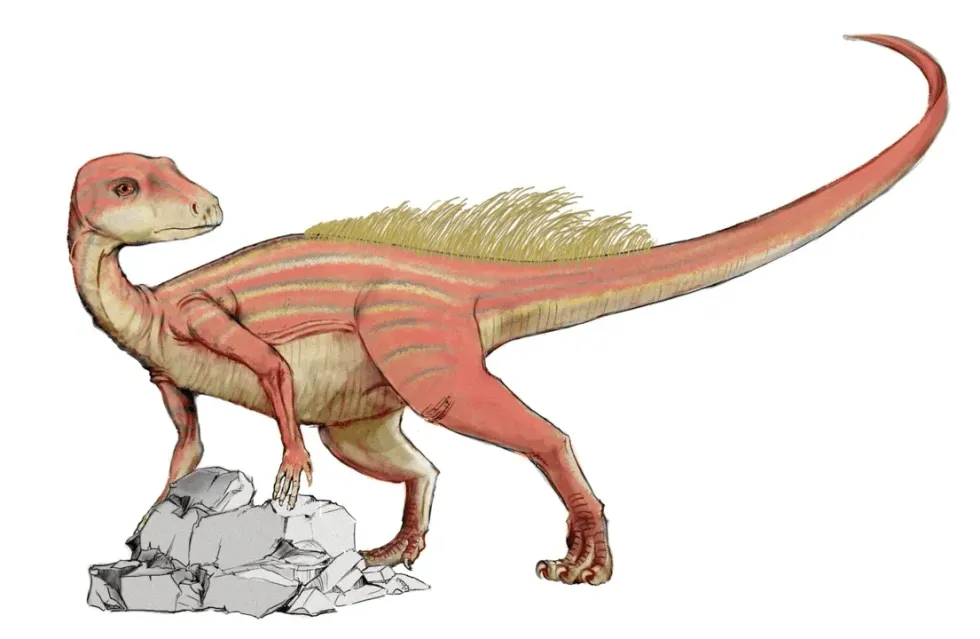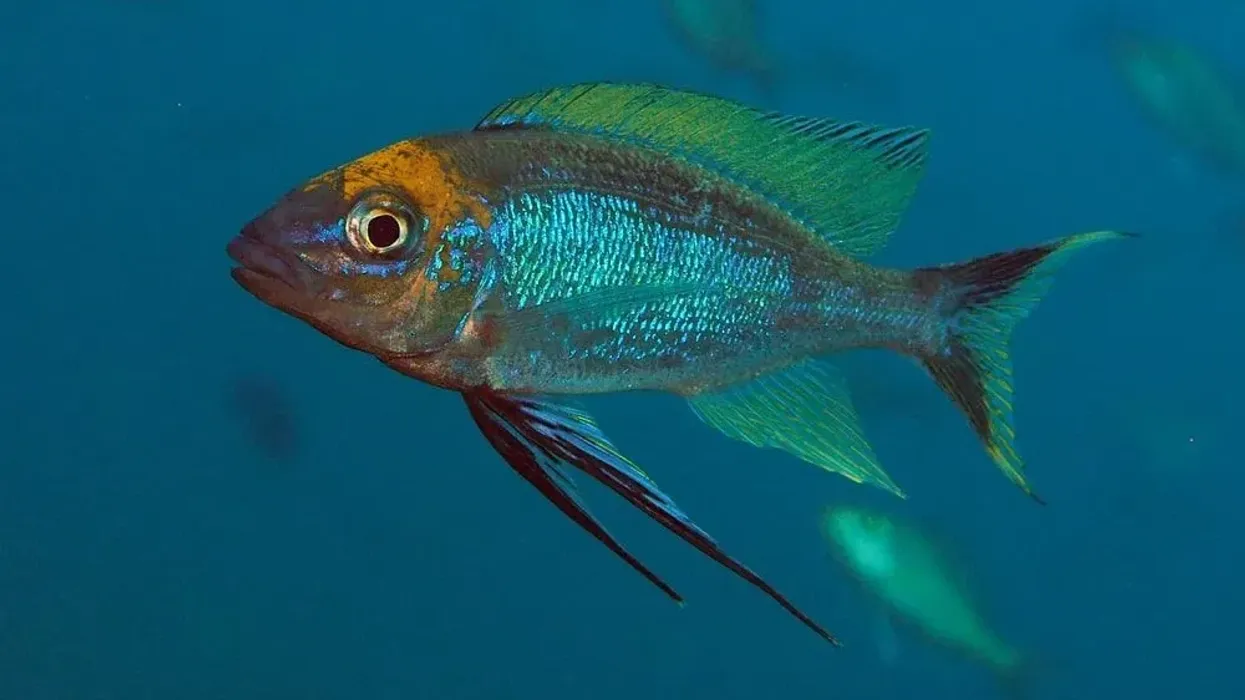Corkwing wrasses (Symphodus melops) of the Perciformes order and the phylum Chordata are cold-water fish that thrive in places such as the Mediterranean and Adriatic seas, the eastern Atlantic Ocean, and around the British Isles, where they're exposed to a temperate climate. The species normally stays close to the surface near rocks but it can also reach great depths.
Their upper depth limit is around 3 ft (1 m), while these reef fish can reach a lower depth limit of 98 ft (30 m).
Wrasses are hermaphrodites and they also have the ability to perform color changes. Males are extremely territorial and have different roles to play.
For example, the male who is the nest guarder is often tricked by male sneakers. Male sneakers tone down their body color and pretend to be a female so that male nest guarders are enticed. Once they get access, male sneakers try to fertilize most of the eggs.
Although prevalent in ample amounts within its habitat, the population distribution of the species is often exploited owing to aquaculture. Learn more here!
For more relatable content, check out these stingray facts and ray facts for kids.
Corkwing Wrasse Interesting Facts
What type of animal is a corkwing wrasse?
A corkwing wrasse (Symphodus melops) is a species of reef fish belonging to the Labridae family. Another scientific name of the species is Crenilabrus melops.
What class of animal does a corkwing wrasse belong to?
Corkwing wrasses have been classified under the class Actinopterygii and the order Perciformes.
How many corkwing wrasses are there in the world?
Due to lack of quantification, an accurate record of mature individuals of the Symphodus melops species in existence cannot be determined. However, according to the International Union for Conservation of Nature (IUCN), their population trend is considered to be quite stable. A record of this species is easily traceable in its range of habitat.
Where does a corkwing wrasse live?
The Mediterranean, Black, and Adriatic seas are home to corkwing wrasses and they are abundant in the eastern Atlantic Ocean too. They can also be found near the British Isles.
What is a corkwing wrasse's habitat?
The habitat range of this Symphodus melops fish encompasses coastal lagoons, reefs, and seagrass or eelgrass beds. They stay close to surfaces covered with rocks or near crevices in the wild, but they can also be found in fisheries and aquariums.
Who do corkwing wrasses live with?
The species enjoys a secluded marine life near rocky beds, but they can also be found in schooling groups.
How long does a corkwing wrasse live?
Corkwing wrasses generally have a shorter life span when compared to other wrasse species. The lives of these fish can reach up to a maximum of nine years. Large-scale utilization of these fish for commercial purposes also contributes to shortening their lifespan.
How do they reproduce?
Spring and summer times are the best for breeding wrasses. Males engage in constructing the nest out of seaweed either in crevices or among rocks and males then guard the nest aggressively. Generally, the clutch size of a wrasse is around 1000 eggs. Females are ovipositors and they engage in spawning eggs.
What is their conservation status?
Unlike the endangered humphead wrasse, corkwing wrasses are plentiful with their population distribution spanning throughout the Mediterranean, Adriatic, and Black seas, and the Atlantic Ocean. Therefore, the conservation status of the corkwing wrasse has been categorized under Least Concern as per the International Union for Conservation of Nature (IUCN) Red List.
Corkwing Wrasse Fun Facts
What do corkwing wrasses look like?
Wrasses vary in shape and size. The physical description of each species renders them a separate identification. Corkwing wrasses are glamorous reef fish in any marine ecosystem. They possess a small-sized body, a long dorsal fin, and a black spot on the tail.
Although they have small mouths, their jaws and teeth are strong. Males have a greenish-blue coloration, whereas females have a yellowish-brown hue. The species comes with five large brown spots around the dorsal fin.
How cute are they?
These fish might not be as cute as a fuzzy teddy bear but corkwing wrasses are definitely a treat to the eyes. The vibrant colors of their body make them stand out throughout their distribution range, from the Mediterranean Sea to the Atlantic Ocean.
How do they communicate?
The modes of communication used by corkwing wrasses are not well-researched. However, it is known that the species mainly engages in visual interaction. Four distinct interactive calls and sounds have also been identified.
How big is a corkwing wrasse?
The average length of corkwing wrasses usually falls in the range of 3.8-4 in (7-10 cm) but it can reach up to a maximum length of 9.8 in (25 cm). It's a small reef fish, undoubtedly smaller than the gigantic Wels catfish, which reached an approximate length of 120-192 in (305-488 cm).
How fast can a corkwing wrasse swim?
These wrasses are one of the fastest marine fish and they can reach great depths of the ocean. They are capable of making sweeping, thrusting, and paddling motions to swim swiftly in an energy-efficient way. However, their exact speed record is yet to be determined.
How much does a corkwing wrasse weigh?
The average weight of these small-sized marine fish is approximately 0.8 lb (0.36 kg) but they can measure up to 1 lb (0.45 kg).
What are their male and female names of the species?
Neither male nor female fish of the species have specific names. They are simply regarded as male and female corkwing wrasse fish.
What would you call a baby corkwing wrasse?
Interestingly, a baby corkwing wrasse is generally called a fry, but once these juveniles grow scales and fins, they are referred to as fingerlings.
What do they eat?
Corkwing wrasses are carnivorous which implies that they enjoy a variety of food in their diet including small worms, crustaceans, mollusks, bryozoans, and hydroids. However, predatory fish such as lionfish and sharks are known to hunt down wrasses.
Are they dangerous?
Wrasses are not believed to be harmful towards humans but they're also known to project aggressiveness at times, especially when put together inside an aquarium. The red-belly wrasse, the rockmover wrasse, and the dragon wrasse also exhibit aggressive behavior. They can engage in violent fights to their death!
Would they make a good pet?
Keeping wrasses as pets is possible. These fish are currently popular in the aquarium trade due to their bright appearance. However, the species is known to be pretty violent, thus making them unsuitable for most aquariums.
Did you know...
Did you know that there are more than 500 wrasse species all over the world?
The genus name of this particular fish has been derived from the Greek terms 'symphysis' meaning 'grown together' and 'odous' meaning 'teeth'.
Can you eat corkwing wrasse?
Wrasses are not too popular for their taste. However, in recent years, the commercial value of the wrasse species has increased significantly as they are fished more and more for consumption.
Corkwing wrasses are edible and are consumed in several countries. Wrasses are considered a delicacy in many Japanese restaurants, especially the Ballan wrasse, which is extremely famous for sashimi.
Are all wrasses born female?
Corkwing wrasses are believed to be protogynous hermaphrodites which means that these wrasses are initially born as females but they eventually turn into males. According to research, around 75% of the wrasse population possesses the capability to change from females to males. This is considered to be a common phenomenon among wrasses.
Here at Kidadl, we have carefully created lots of interesting family-friendly animal facts for everyone to discover! Learn more about some other fish from our giant grouper facts and Nassau grouper facts pages.
You can even occupy yourself at home by coloring in one of our free printable wrasse coloring pages.









